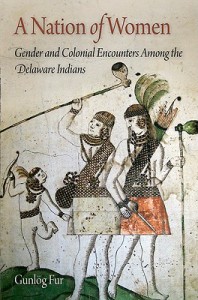This post is an excerpt from a conversation I had earlier this week, where I take issue with the idea that sex roles are necessarily a sign of subjugation.
Some eastern Native American tribes were/are matriarchal. These tribes had less extensive sex roles than European cultures and were less rigid in enforcing these roles, but they did exist. The Delaware were one matriarchal culture with flexible but hardly non-existent sex roles.
Delaware called themselves “A Nation of Women” meaning “we follow the women’s way.” Women owned all the land, even the land men hunted on. Decisions were made by the clan mothers, who were old women, and chiefs carried out their decisions. It was hierarchical, certainly, but not patriarchal.
When European men refused to negotiate treaties with women, only men, the chiefs dressed in women’s ceremonial regalia to participate in the negotiations and called themselves “queens,” because only women could cede land. The whole band would wait on the outskirts of the place where negotiation was occurring. The chiefs would take frequent recesses to confer with the women elders during the negotiations, because they could not make binding commitments without them.
The concept of “chief” itself is a Euro-centric one, that had even stronger male connotations in the 17th century. I doubt that a European man would have bestowed that title on any woman, no matter how powerful.
Delaware women fed everyone, which was another conventional women’s role. The men did not cook or clean the game, usually. The women also distributed the food, all the food, no small thing in a time where food was the most precious material good. Women conducted trade, because women controlled possessions and their distribution. Women’s control over food was an expression not of subjugation but power.
Because young women were often pregnant or breastfeeding, and because women have less upper-body strength, some division of labor by sex would have been natural. Such divisions make less sense today than in the past. For example, when moving from winter to summer habitations, Delaware women would carry all the possessions while men kept their hands free. That was so if the band was attacked, the men, trained in warfare, could fight back immediately. European men saw the amount of heavy lifting Delaware women did and concluded they were severely oppressed.
The modern concept of “gender” is a highly individualistic one, about expressing one’s “true self.” Many, if not most, indigenous American cultures did not see what we call “gender” as an expression of personality. Rather, what we call sex roles were taken as a way of giving to the greater community, based on needs of the whole, not the individual. If Delaware chiefs had to become “queens” to negotiate a treaty for the good of the tribe, they would undertake that sex role. It wasn’t about how they felt about themselves.
American pioneer communities also saw a breakdown in sex roles, with men and women both taking on activities that were highly coded as opposite sex in the cultures they came from. This was done for the survival of the larger family unit. This idea of gender as soul expression is not the way it has always been, even for White Americans.
I wrote about Gunlog Fur’s book, A Nation of Women, on my blog. https://hearthmoonrising.com/a-nation-of-women-part-ii/
American Indian cultures do challenge core ideas about matriarchy: that is is always peaceful or always non-hierarchical or always non-gendered. No culture fits the feminist ideal of what a “matriarchy” is, though it’s a fine ideal to strive for.
A book about matriarchies that I love is Matriarchal Societies by Heide Gottner-Abendroth. She only spends part of her focus on the Americas.
https://books.google.com/books/about/Matriarchal_Societies.html?id=awXIXwAACAAJ
She doesn’t fall into the trap of assuming all American Indian cultures fit a certain mold, though she doesn’t seem to have been aware of the Delaware when she wrote her book.
Perhaps the idea of what a matriarchy is cannot be fathomed at this point in history. Right now we seem to define it as an absence: an absence of sex roles or war or inequality or hierarchy. We can’t seem to define it in any positive way, even when studying cultures where women have power. In the 19th century, people defined matriarchy as anything better for women. The ancient Celts were called matriarchal then, though they aren’t today. We probably need to scuttle our current definition of matriarchy (or liberation) and find a better one.


 What happens when your world gets turned upside down and in the confusion of reevaluating all that you thought true, the people you regarded as allies distance themselves or judge you?
What happens when your world gets turned upside down and in the confusion of reevaluating all that you thought true, the people you regarded as allies distance themselves or judge you?